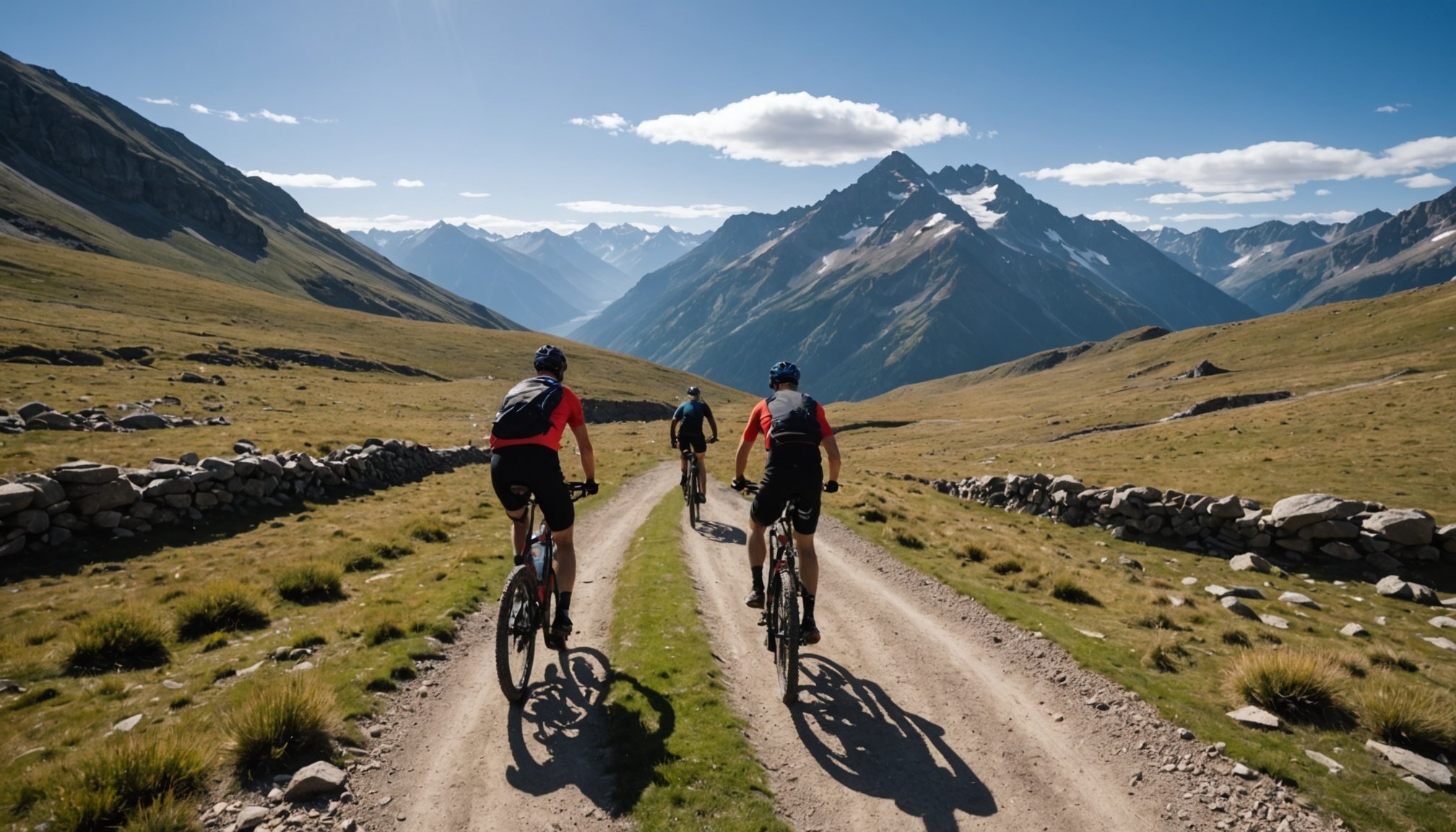Creating High-Altitude Training Environments for Mountain Bikers: A Comprehensive Guide
Understanding the Importance of Altitude Training
When it comes to mountain biking, especially at high altitudes, the body faces unique challenges that can significantly impact performance. At higher elevations, the air contains less oxygen, a condition known as hypoxia. This reduction in oxygen availability forces the body to adapt in various ways, such as increasing red blood cell production to carry more oxygen to the muscles.
“Training at high altitudes is crucial for mountain bikers because it helps the body adapt to low oxygen levels, which can enhance endurance and overall performance,” explains a seasoned mountain biker who has tackled the infamous Mauna Kea climb in Hawaii. “The 42% less oxygen at the summit of Mauna Kea compared to the start is a stark example of the challenges high-altitude training poses and the benefits it offers”.
Also read : Top Strategies for Optimal Recovery After Competing in a Pentathlon
Methods for Simulating High-Altitude Training
Hypoxic Training Chambers
One of the most advanced methods for simulating high-altitude conditions is using hypoxic training chambers. These chambers can be set to mimic the oxygen levels found at various altitudes, allowing athletes to train in a controlled environment.
- Cost-Effective: While the initial investment is high, these chambers can be used by multiple athletes, making them a cost-effective option in the long run.
- Controlled Environment: Athletes can train in a consistent and controlled environment, which is particularly useful for those who cannot travel to high-altitude locations.
- Customizable: The oxygen levels can be adjusted to simulate different altitudes, allowing athletes to gradually acclimate to higher elevations.
High-Altitude Training Camps
Training camps located at high altitudes are another popular option. These camps offer a natural high-altitude environment where athletes can train and acclimate over a period of time.
Also to see : Essential Guidelines for Selecting the Best Protective Gear for Competitive Skateboarding
| Location | Elevation | Facilities | Cost |
|---|---|---|---|
| St. Moritz, Switzerland | 6,000 ft | Pool, track, cable cars to trails | High |
| Font-Romeu, France | 6,000 ft | Track, open-water swimming lakes, cycling routes | Moderate |
| Flagstaff, Arizona | 7,000 ft | Forested trails, aquatic center | Moderate |
| Windhoek, Namibia | 5,500 ft | Cycling variety, running trails | Low |
“These training camps are not just about the altitude; they offer a holistic training experience with access to various facilities and scenic routes,” notes Richard Murray, a professional triathlete who has trained in Font-Romeu, France.
Breathwork-Based Training
Breathwork-based coaching is a newer approach that helps athletes prepare for high-altitude training without actually being at high elevations. This method focuses on specific breathing techniques to simulate the effects of high altitude.
- Accessibility: This method can be practiced anywhere, making it accessible to athletes who cannot travel to high-altitude locations.
- Cost-Effective: It does not require any special equipment, making it a budget-friendly option.
- Holistic Benefits: Breathwork can also improve overall respiratory health and mental focus.
“Breathwork-based coaching is a game-changer for athletes who need to train for altitude but are limited by their location. It helps the body adapt to low oxygen levels through specific breathing exercises,” says a coach from Recal Travel, which offers a 5-week breathwork training program.
Practical Tips for High-Altitude Training
Acclimatization
Acclimatization is key when training at high altitudes. Here are some practical tips to help athletes acclimate effectively:
- Gradual Ascent: Ascend gradually to higher altitudes to allow the body to adapt. For example, if you are planning to train at 10,000 feet, start by spending a few days at 7,000 feet before moving higher.
- Hydration: Stay well-hydrated as dehydration can exacerbate altitude sickness.
- Rest and Recovery: Ensure adequate rest and recovery time. High-altitude training can be more strenuous, so it’s crucial to listen to your body.
Monitoring Heart Rate and Performance
Monitoring heart rate and performance metrics is essential during high-altitude training.
- Heart Rate Variability: Use tools like heart rate variability (HRV) to assess how your body is adapting to the altitude. Lower HRV can indicate stress and the need for rest.
- Power Output: Track your power output to see how your body is performing under hypoxic conditions. This can help you adjust your training intensity and volume.
- Interval Training: Incorporate interval training to simulate high-intensity efforts at high altitudes. This can help improve cardiovascular endurance and muscular performance.
Nutrition and Supplements
Proper nutrition and supplementation can help support the body during high-altitude training.
- Iron Supplements: Iron is crucial for red blood cell production. Ensure you have adequate iron levels, especially if you are training at high altitudes.
- Hydration and Electrolytes: Maintain proper hydration and electrolyte balance to prevent dehydration and electrolyte imbalances.
- Carbohydrates and Protein: Focus on a balanced diet rich in carbohydrates and protein to support energy production and muscle repair.
Common Challenges and Solutions
Altitude Sickness
Altitude sickness, or acute mountain sickness (AMS), is a common challenge faced by athletes training at high altitudes.
- Symptoms: Headaches, nausea, fatigue, and shortness of breath are common symptoms of AMS.
- Prevention: Gradual acclimatization, staying hydrated, and avoiding overexertion can help prevent AMS.
- Treatment: If symptoms occur, descend to a lower altitude and rest. In severe cases, medical attention may be necessary.
Low Oxygen Levels
Training in low oxygen environments can be challenging, but there are ways to mitigate the effects.
- Breathing Techniques: Use specific breathing techniques to help the body adapt to low oxygen levels.
- Paced Training: Train at a pace that allows you to maintain a consistent heart rate and avoid overexertion.
- Rest and Recovery: Ensure adequate rest and recovery time to allow the body to adapt to the low oxygen environment.
Real-Life Examples and Anecdotes
Training on Mauna Kea
Mauna Kea in Hawaii is one of the most challenging high-altitude bike climbs in the world. The climb starts at sea level and ascends to 13,842 feet, with the final segment averaging a 9.5% gradient.
“Training on Mauna Kea was an eye-opening experience. The gravel and sand sections just past the visitor center were particularly challenging, but the scenery and the sense of accomplishment made it all worth it,” recalls a cyclist who completed the climb. “It’s essential to have the right gear, like a gravel bike or mountain bike, and to be prepared for the extreme weather conditions at the summit”.
Professional Athletes’ Experiences
Professional athletes often train at high altitudes to gain a competitive edge. For example, Kristian Blummenfelt and Gustav Iden, Norwegian triathletes, trained in Flagstaff, Arizona, to prepare for the Ironman World Championships.
“Flagstaff offers a perfect blend of high altitude and varied training routes. The forested trails and the aquatic center made our training camp both challenging and enjoyable,” says Kristian Blummenfelt. “Training at 7,000 feet helped us build the endurance and performance we needed to compete at the highest level”.
Creating a high-altitude training environment for mountain bikers involves a combination of advanced methods, practical tips, and a deep understanding of the body’s adaptation to low oxygen levels. Whether through hypoxic training chambers, high-altitude training camps, or breathwork-based coaching, athletes can prepare themselves for the challenges of mountain biking at high elevations.
By monitoring heart rate and performance metrics, focusing on proper nutrition and hydration, and being aware of the common challenges like altitude sickness, athletes can optimize their training and achieve better performance. Real-life examples from professional athletes and challenging climbs like Mauna Kea underscore the importance and benefits of high-altitude training.
In the end, high-altitude training is not just about the physical adaptations; it’s also about mental toughness and the will to push beyond your limits. As any seasoned mountain biker will tell you, the rewards of training high are well worth the effort.











